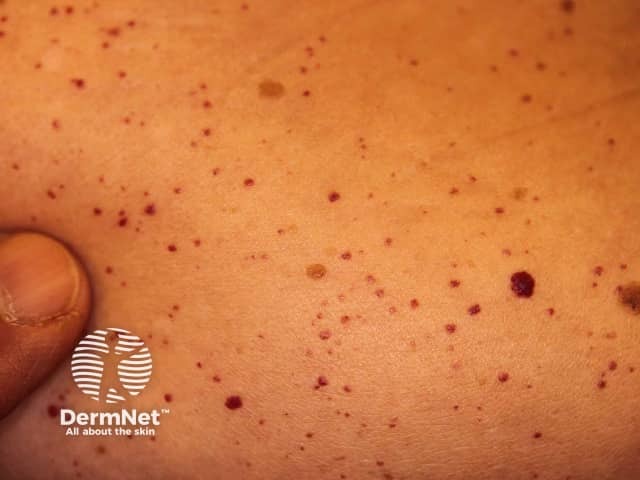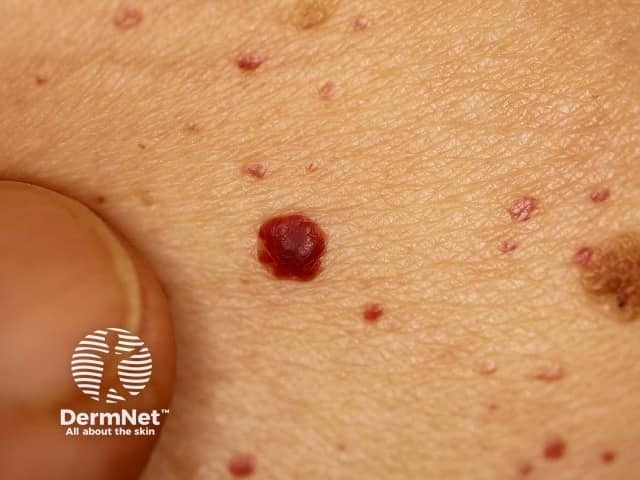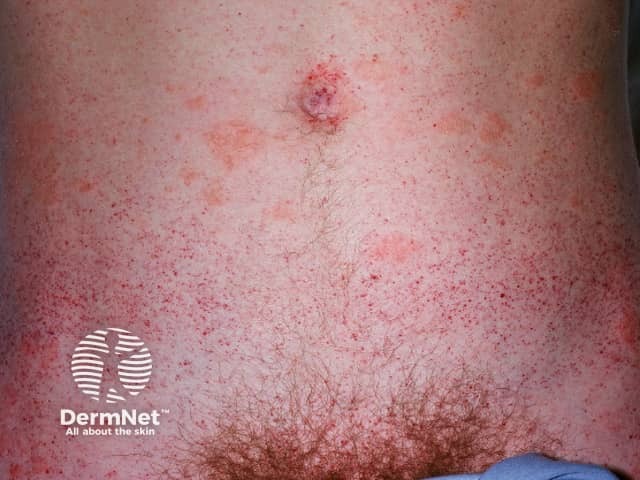Main menu
Common skin conditions

NEWS
Join DermNet PRO
Read more
Quick links
Fabry disease — extra information
Fabry disease
Author: Qiuyu Jin, Medical Student, University of Auckland, Auckland, New Zealand. DermNet Editor in Chief: Adjunct A/Prof Amanda Oakley, Dermatologist, Hamilton, New Zealand. Copy edited by Gus Mitchell/Maria McGivern. July 2019.
Introduction Demographics Causes Clinical features Complications Diagnosis Differential diagnoses Treatment Outcome
What is Fabry disease?
Fabry disease is a rare inherited lysosomal storage disorder [1]. It is also known as Anderson–Fabry disease and angiokeratoma corporis diffusum.
Fabry disease causes clusters of angiokeratomas (small, dark red spots on the skin) and many systemic symptoms due to the deposition of globotriaosylceramide (Gb3) in multiple organs.

Angiokeratomas in suspected Fabry disease

Angiokeratomas in suspected Fabry disease

Angiokeratomas in Fabry disease
Who gets Fabry disease?
The estimated prevalence in males is about one in 40,000–60,000 of the population [2]. Fabry disease generally affects men and boys more severely and at an earlier age than women and girls because its inheritance is X-linked (the male sex only carries one X chromosome whereas females have two). Fabry disease can occur in all ethnic groups [3].
The age of onset of Fabry disease can range from the second to the fifth decade of life or later.
Fabry disease often presents with non-specific symptoms that can be mild and subtle, and it is commonly missed or misdiagnosed, leading to an underestimation of its prevalence [4].
What causes Fabry disease?
Fabry disease is caused by a mutation of the alpha-galactosidase A gene (GLA) mapped to the long arm of the X chromosome [5]. There are hundreds of different pathogenic variants of the mutation, resulting in differing symptoms and variable severity [6]. Men with Fabry disease pass the gene on to all daughters but to none of their sons. Women with Fabry disease have a 50% chance of passing the gene onto their daughters or to their sons. Some women and girls are affected as severely as men and boys due to a random X chromosome inactivation [7].
Gb3 is an intermediate in the degradative pathway of globoside (a glycosphingolipid), a major component of some cell membranes. The enzyme alpha-galactosidase A catalyses the cleavage (separation) of the terminal galactose from Gb3. Lack of the alpha-galactosidase A enzyme leads to accumulation of Gb3 in various tissues, leading to cell death. The most clinically significant sites of accumulation of Gb3 are blood vessels of the skin, heart, nerves, and kidneys [8].
What are the clinical features of Fabry disease?
The characteristic features of Fabry disease are:
- Clusters of angiokeratomas (small, dark red papules)
- Heat intolerance and hypohidrosis (reduced sweating)
- Episodes of acroparesthesia (neuropathic pain in the hands and feet) (acroparaesthesia), precipitated by stress or extremes of temperature
- Cloudiness of the cornea
- Hearing loss [9]
- Abdominal symptoms such as pain, nausea, vomiting, and either diarrhoea or constipation [10]
- Recurrent fever, fatigue, psychological, and social issues
- Serious and potentially life-threatening complications including kidney damage, heart disease, and stroke [11].
Dermatological manifestations occur in more than 70% of patients with Fabry disease, with a mean age of onset at 17 years [3].
Angiokeratomas
Angiokeratomas are dilated blood vessels in the upper dermis, presenting as red or black papules. The papules do not blanch with pressure, and older lesions can become warty. Clusters or diffuse angiokeratomas first appearing in young adults must alert physicians to a possible diagnosis of Fabry disease.
In Fabry disease, angiokeratomas are caused by the accumulation of Gb3 in the dermal endothelial cells, which leads to bulge and incompetence of the vessel walls [12]. The angiokeratomas usually localise in the bathing suit area (from the umbilicus to the upper thighs, including the genitals). More than one-third of patients also develop angiokeratomas and telangiectasia on the lips and inside the mouth [13].
There is no correlation between the severity of the disease and the extent of angiokeratomas [14].
Hypohidrosis
Hypohidrosis is a common feature of Fabry disease that leads to dry skin and heat intolerance [15]. It is likely the result of an abnormal autonomic nerve response due to Gb3 deposition.
Other cutaneous manifestations of Fabry disease
Fabry disease is identifiable by other skin signs, such as:
- Lymphoedema of the lower legs [14]
- Sparse and fine facial hair [14]
- Raynaud phenomenon [15].
What are the complications of Fabry disease?
The three most serious complications of Fabry disease are kidney disease, cardiac disease, and cerebrovascular disease [3].
- Kidney disease ranges from isolated proteinuria to end-stage renal failure [3].
- The cardiac disease seen in conjunction with Fabry disease includes left ventricular hypertrophy, heart failure, coronary artery disease, and arrhythmias.
- Cerebrovascular disease includes transient ischaemic attacks and ischaemic strokes.
How is Fabry disease diagnosed?
Male and female patients are diagnosed differently.
- Male patients can be diagnosed by a blood test. A very low level of alpha-galactosidase A activity (< 3%) is enough to diagnose Fabry disease while a level above 35% excludes Fabry disease. Levels of activity in between these two figures require a genetic analysis to confirm the diagnosis.
- Female patients have variable enzyme activities with a significant proportion showing normal activity, thus the diagnosis of Fabry disease should be by genetic analysis.
- If the genetic analysis does not identify a disease-causing mutation specific for Fabry disease, a biopsy of the affected organs (including skin biopsy) can be considered; this may show intracellular accumulation of Gb3 [3,14].
Family members of the diagnosed patient should also be tested for Fabry disease.
Urinalysis and ECG should be undertaken to detect renal and cardiac abnormalities.
What is the differential diagnosis for Fabry disease?
Due to its rarity and the wide range of non-specific clinical features, Fabry disease is often misdiagnosed, and is colloquially considered a “great imposter” condition [16].
Angiokeratomas are not characteristic of Fabry disease as solitary lesions can occur in healthy individuals. They are also found in patients with hereditary haemorrhagic telangiectasia and in the other lysosomal disorders, including:
- Schindler disease (a rare inherited metabolic disorder)
- Fucosidosis (a rare lysosomal storage disorder that results in a potentially deadly buildup of sugars)
- Aspartylglucosaminuria (a disorder resulting from a defect in the enzyme aspartylglucosaminidase)
- Beta-mannosidosis (a disorder resulting from decreased activity of the enzyme beta-mannosidase)
- Sialidosis (a metabolic disorder caused by a deficiency of the enzyme neuraminidase) [12,14].
The most commonly mistaken diagnoses are the following:
- Rheumatological conditions such as rheumatic fever or dermatomyositis — in these cases, the dermatological manifestations are different in appearance and time course
- Neuropsychological disease and fibromyalgia — in which there is an absence of cardiac, kidney, nerve, and skin involvement
- Polycythaemia vera and essential thrombocythaemia — Fabry disease does not cause an increased platelet count
- Hereditary haemorrhagic telangiectasia — Fabry disease does not usually cause spontaneous epistaxis or gastrointestinal bleeding
- Irritable bowel syndrome — this has no other systemic manifestations [4,17].
What is the treatment for Fabry disease?
Once diagnosed, male patients with Fabry disease are often prescribed enzyme replacement therapy, regardless of the clinical features [9,14,18]. Female patients should only receive treatment if they have significant clinical manifestations.
Enzyme replacement therapy provides patients with the deficient enzyme alpha-galactosidase A. It reduces the severity and progression of disease manifestations, especially neuropathic pain and kidney disease, by reducing the tissue deposition of Gb3. The effect of enzyme replacement therapy on cardiovascular manifestations is less clear [18].
Patients with Fabry disease may require input from different specialities input including from GPs, cardiologists, nephrologists, neurologists, and dermatologists to manage their individual organ manifestations. Neuropathic pain of the hand and feet may respond to anticonvulsants, such as carbamazepine [18,19].
Treatment for angiokeratomas includes cryotherapy, electrocoagulation, excisional surgery, and laser therapy [12,14,20].
What is the outcome for Fabry disease?
Fabry disease is progressive and usually results in a shortened life expectancy. The prognosis varies from patient to patient [21]. Survival is significantly reduced in male patients with severe forms of Fabry disease to below 60 years, often to 40 or 50 years. Most deaths are due to cardiovascular disease including stroke, myocardial infarction, and heart failure. Death from renal failure, sepsis, and suicide have also been reported [18]. The benefit of enzyme replacement therapy on overall prognosis is unclear due to a lack of current evidence [18,22,23].
References
- Germain DP. Fabry disease. Orphanet J Rare Dis 2010; 5: 30. DOI: 10.1186/1750-1172-5-30. PubMed
- Genetic Home Reference. Fabry Disease. June 2018. Available at: https://ghr.nlm.nih.gov/condition/fabry-disease#statistics (accessed 4 June 2019).
- Mauer M, Kopp JB, Schiffmann R. Fabry disease: Clinical features and diagnosis. UpToDate. Updated May 2018. Available at: www.uptodate.com/contents/fabry-disease-clinical-features-and-diagnosis (accessed 4 June 2019).
- Houge G, Skarbøvik AJ. Fabry disease — a diagnostic and therapeutic challenge. Tidsskr Nor Laegeforen 2005; 125: 1004–6. PubMed
- Bishop DF, Kornreich R, Desnick RJ. Structural organization of the human alpha-galactosidase A gene: further evidence for the absence of a 3' untranslated region. Proc Natl Acad Sci USA 1998; 85: 3903–7. DOI: 10.1073/pnas.85.11.3903. PubMed
- Schaefer E, Mehta A, Gal A. Genotype and phenotype in Fabry disease: analysis of the Fabry Outcome Survey. Acta Paediatr Suppl 2005; 94: 87–92. DOI: 10.1111/j.1651-2227.2005.tb02119.x. PubMed
- Echevarria L, Benistan K, Toussaint A, et al. X-chromosome inactivation in female patients with Fabry disease. Clin Genet 2016; 89: 44–54. DOI: 10.1111/cge.12613. PubMed
- Uceyler N, Schroter N, Kafke W, et al. Skin globotriaosylceramide 3 load is increased in men with advanced Fabry disease. PLoS One 2016; 11(11): e0166484. DOI: 10.1371/journal.pone.0166484. DOI: 10.1371/journal.pone.0166484. PubMed
- Lysosomal Disease New Zealand. Fabry disease. Available at: www.ldnz.org.nz/lysosomal-diseases/list-of-lysosomal-diseases/fabry-disease/ (accessed 4 June 2019).
- Hoffman B, Schwarz M, Mehta A, Keshav S; Fabry Outcome Survey European Investigators. Gastrointestinal symptoms in 342 patients with Fabry disease: prevalence and response to enzyme replacement therapy. Clin Gasterenterol Hepatol 2007; 5: 1447–53. DOI: 10.1016/j.cgh.2007.08.012. PubMed
- Fabry Community. How dermatologists can help. Available at: www.discoverfabry.com/ (accessed June 4 2019).
- Lidove O, Jaussaud R, Aractingi A. Chapter 24: Dermatological and soft-tissue manifestations of Fabry disease: characteristics and response to enzyme replacement therapy. In: Mehta A, Beck M, Sunder-Plassman G (eds) Fabry disease: perspectives from 5 years of FOS. Oxford: Oxford PharmaGenesis; 2006.
- Baccaglini L, Schiffmann R, Brennan MT, et al. Oral and craniofacial findings in Fabry’s disease: a report of 13 patients. Oral Surg Oral Med Oral Pathol Oral Radiol Endod 2001; 92: 415–9. DOI: 10.1067/moe.2001.114833. PubMed
- Luna PC, Boggio P, Larralde M. Dermatologic aspects of Fabry disease. J Inborn Errors Metab Screen 2016; 4: 1–7. DOI: 10.1177/2326409816661353. Journal
- Germain D, Atanasiu OI, Akrout-Marouene J, Benistan K. Raynaud’s phenomenon associated with Fabry disease. J Inherit Metab Dis 2015; 38: 367–8. DOI: 10.1007/s10545-014-9799-z. PubMed
- Lidove O, Kaminsky P, Hachulla E. Fabry disease 'The New Great Imposter': results of the French Observatoire in Internal Medicine Departments (FIMeD). Clin Genet 2012; 81: 571-7. DOI: 10.1111/j.1399-0004.2011.01718.x. PubMed
- Mehta A, Ricci R, Widmer U, et al. Fabry disease defined: baseline clinical manifestations of 366 patients in the Fabry Outcome Survey. Eur J Clin Invest 2004; 34: 236–42. DOI: 10.1111/j.1365-2362.2004.01309.x. PubMed
- Mauer M, Kopp JB, Schiffman R. Fabry disease: Treatment and prognosis. UpToDate. Updated August 2017. Available at: https://www.uptodate.com/contents/fabry-disease-treatment (accessed 4 June 2019)
- Fabry Support & Information Group. What is Fabry disease? Available at: http://www.fabry.org/fsig.nsf/pages/fabry (accessed June 4 2019).
- Möhrenschlager M, Barun-Falco M, Ring J, Abeck D. Fabry disease: recognition and management of cutaneous manifestations. Am J Clin Dermatol. 2013; 4: 189–96. DOI: 10.2165/00128071-200304030-00005. PubMed
- Fabry Community. Fabry disease progression. Available at: www.fabrycommunity.com/en/Patients/Education/Progression.aspx (accessed June 4 2019).
- Carbrera G, Politei J, Antongiovani N, Amartino H. Effectiveness of enzyme replacement therapy in Fabry disease: Long term experience in Argentina. Mol Genet Metab Rep 2017; 11: 65–8. DOI: 10.1016/j.ymgmr.2017.02.005. PubMed
- Algera T, Vairo F, de Souza MV, Krug BC, Schwartz IVD. Enzyme replacement therapy for Fabry disease: A systematic review and meta-analysis. Genet Mol Biol 2012; 35(4 Suppl): 947–54. DOI: 10.1590/s1415-47572012000600009. PubMed
On DermNet
Other websites
- Lysosomal Diseases New Zealand
- DiscoverFABRY
- Fabry Support & Information Group
- Genetic Home Reference
